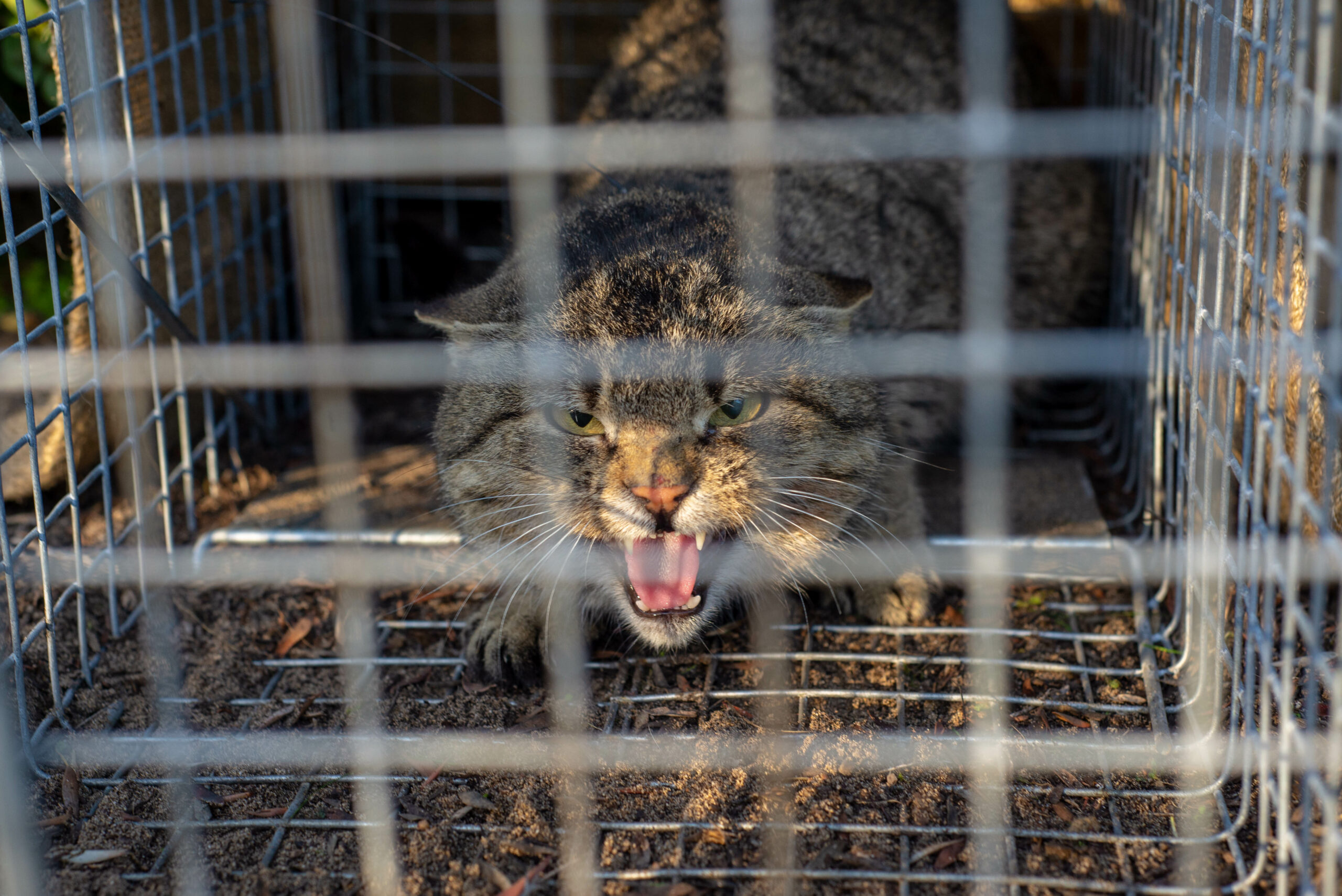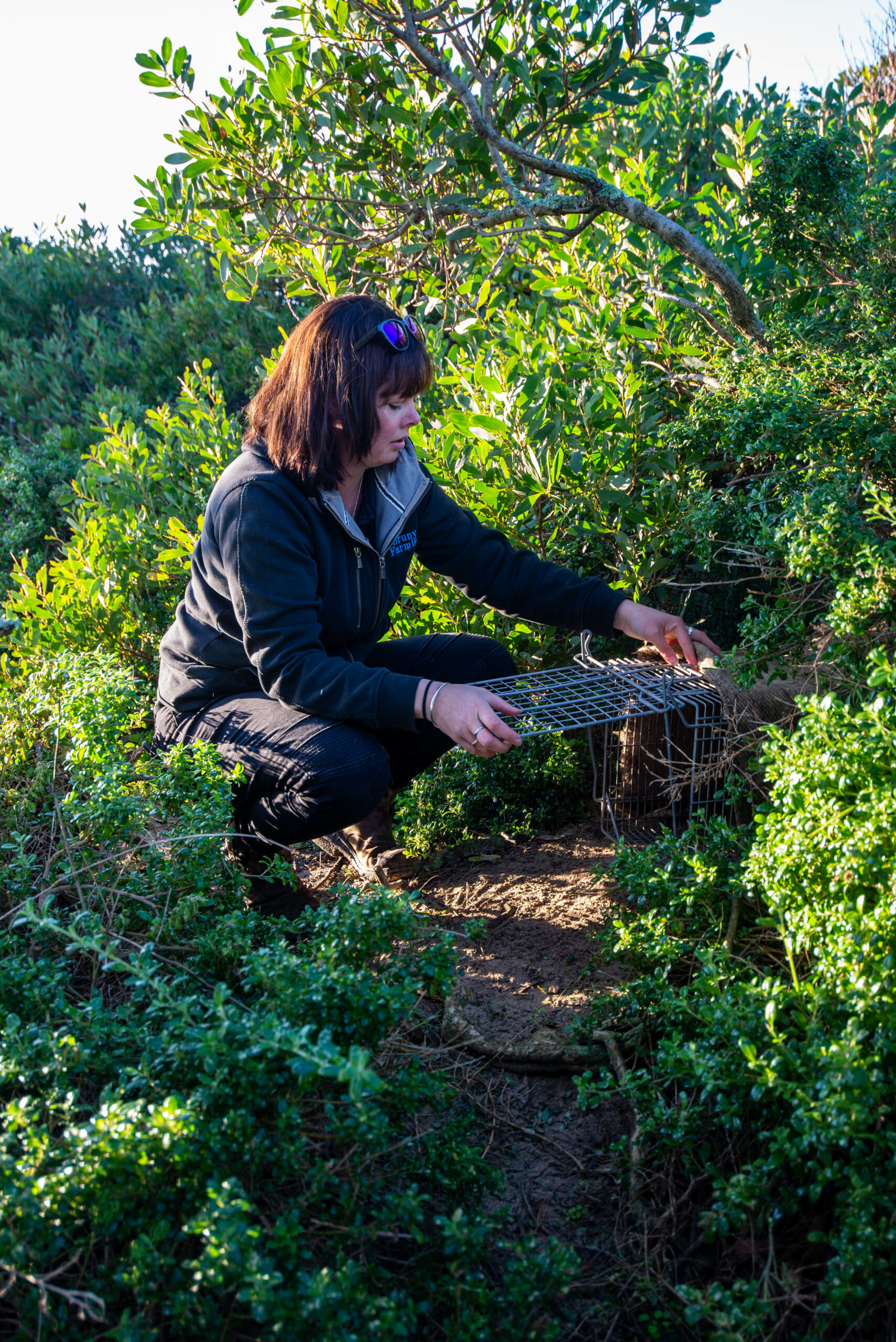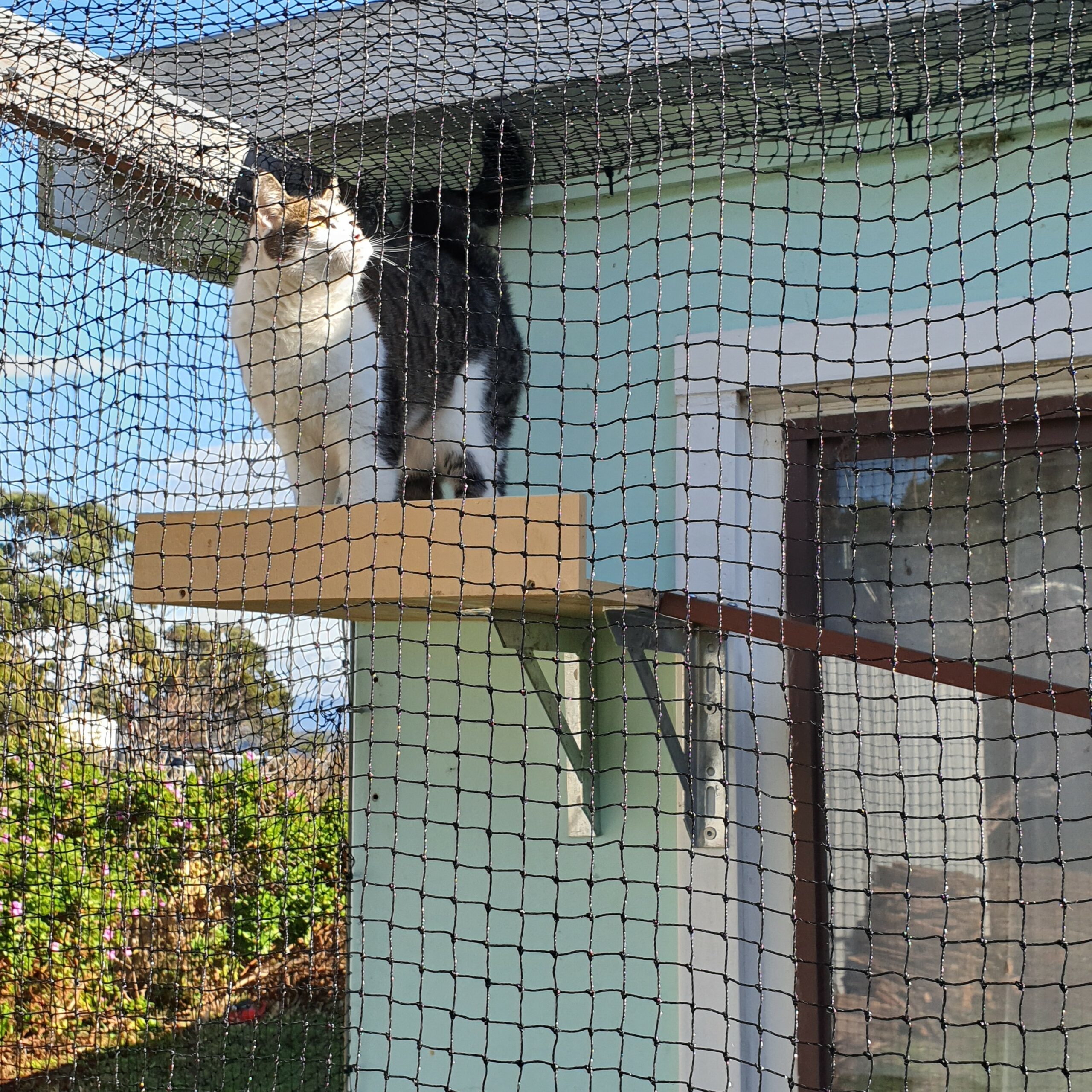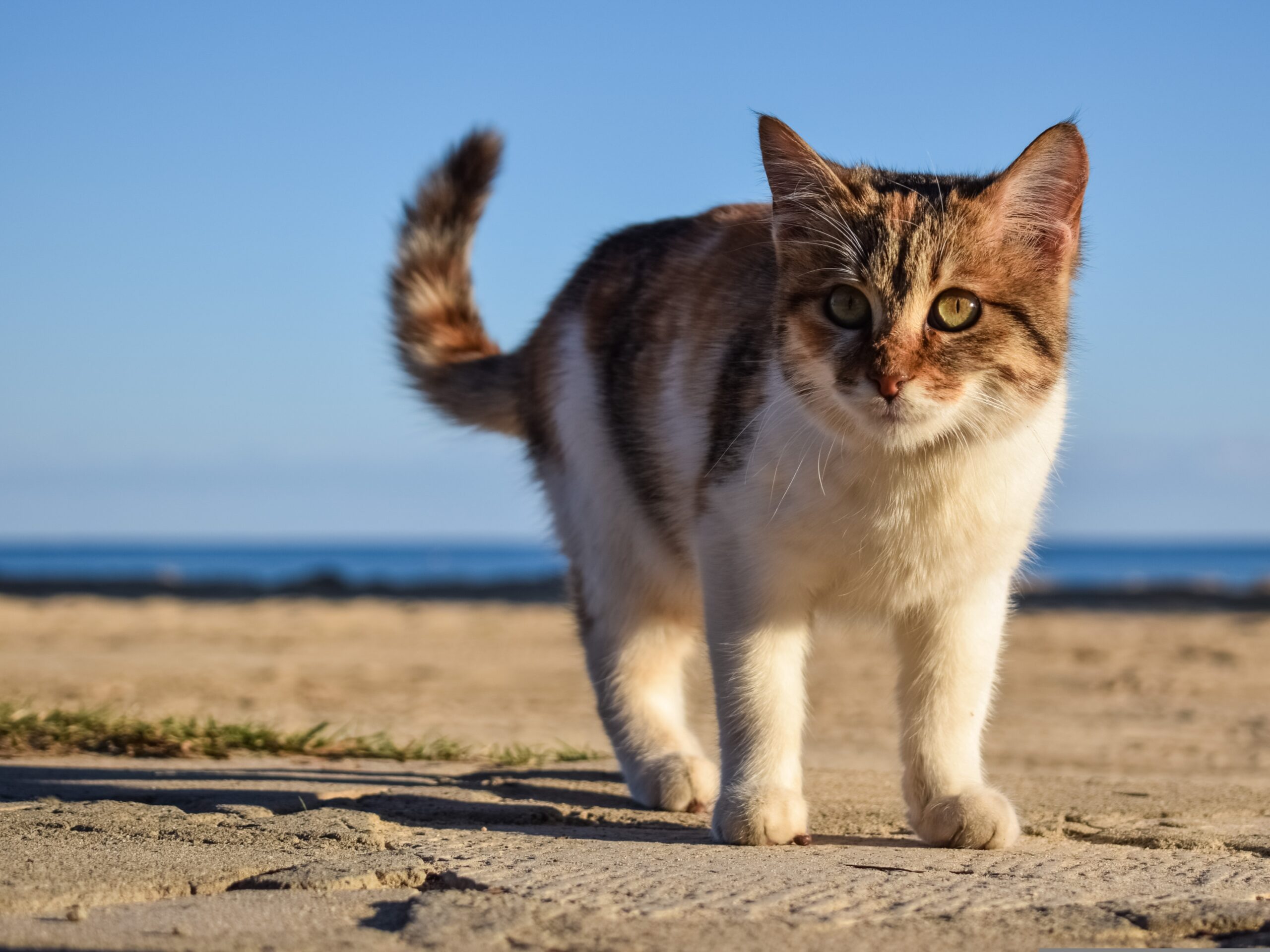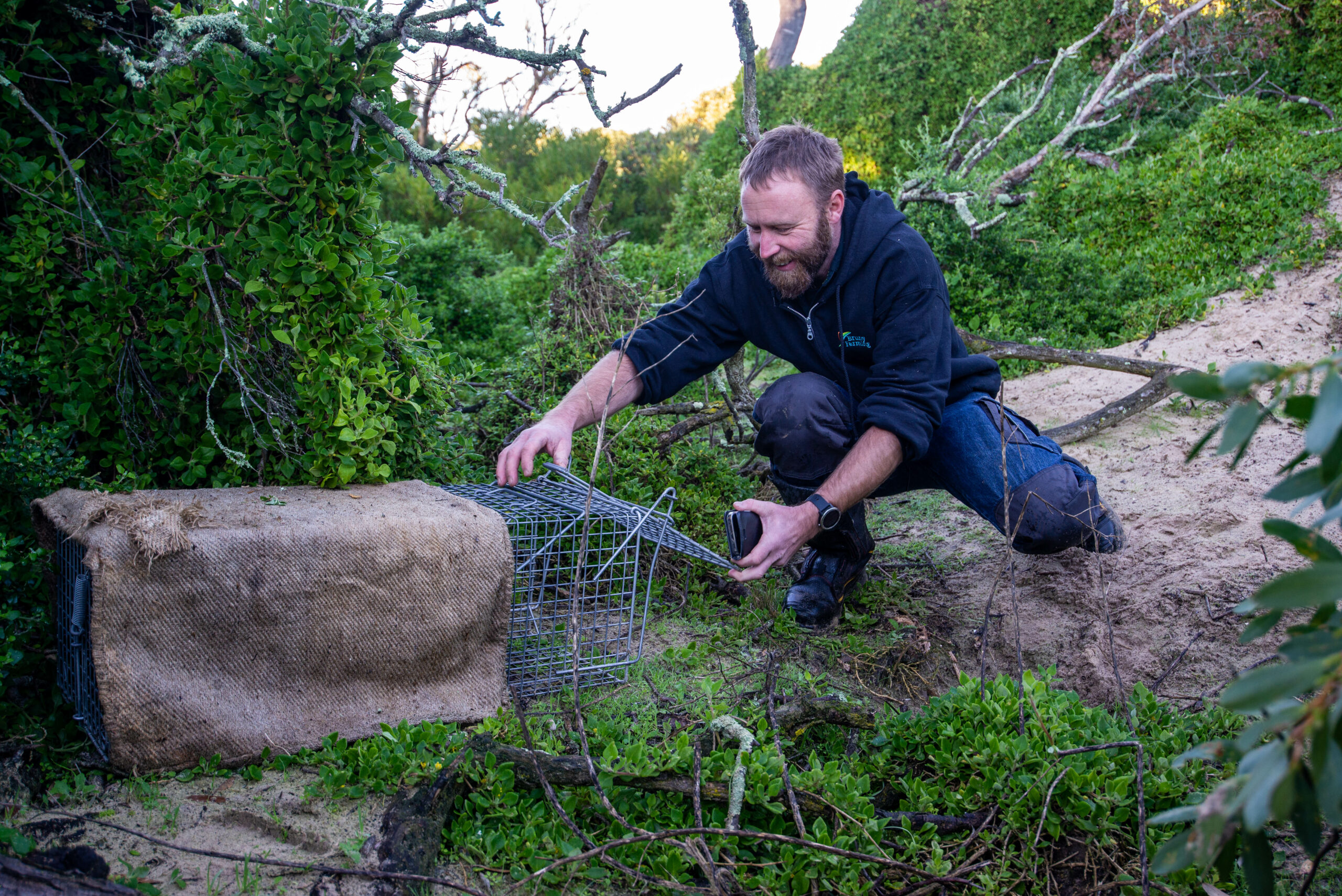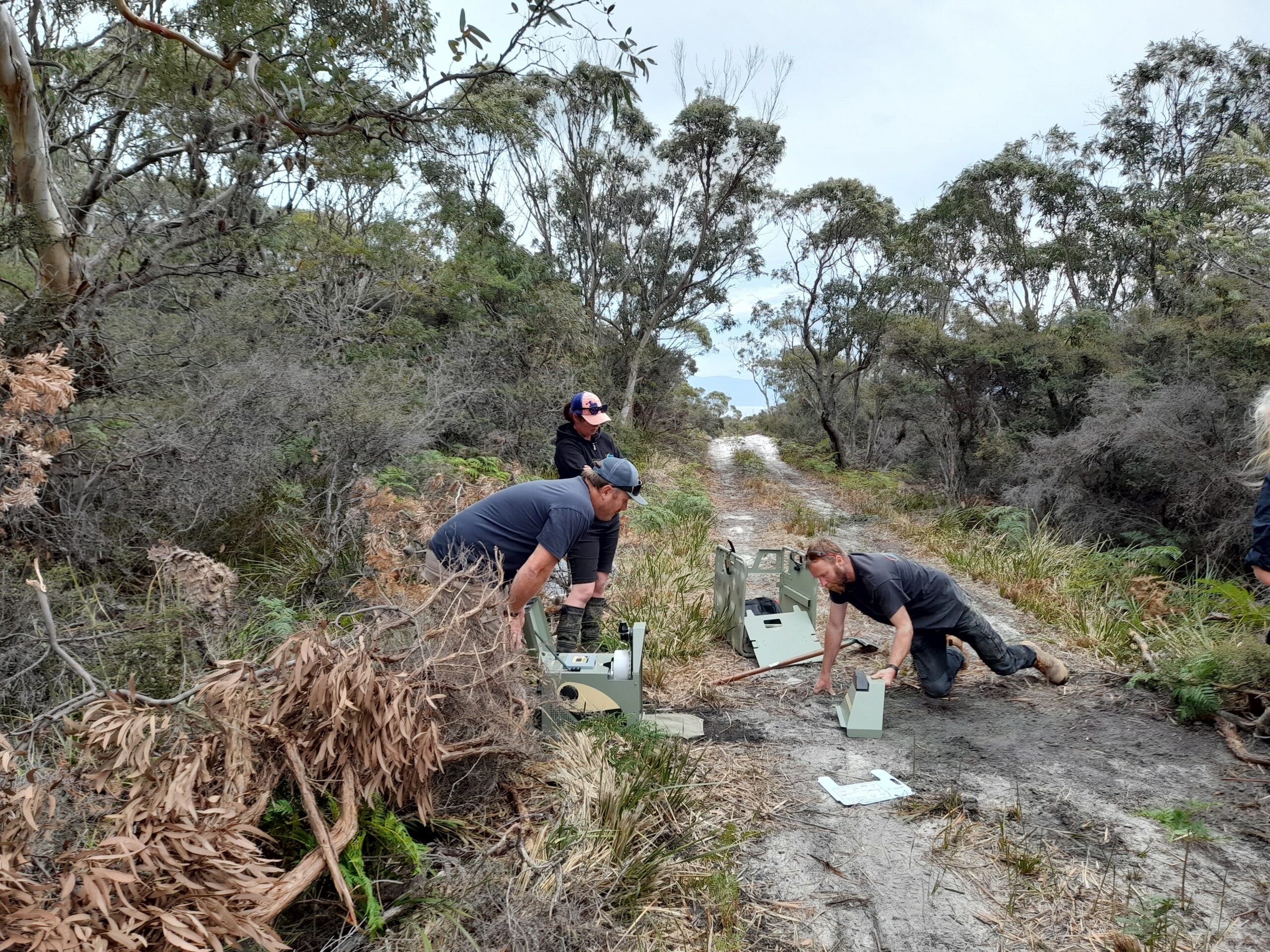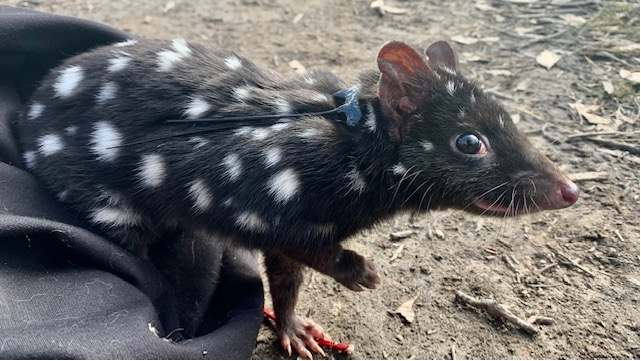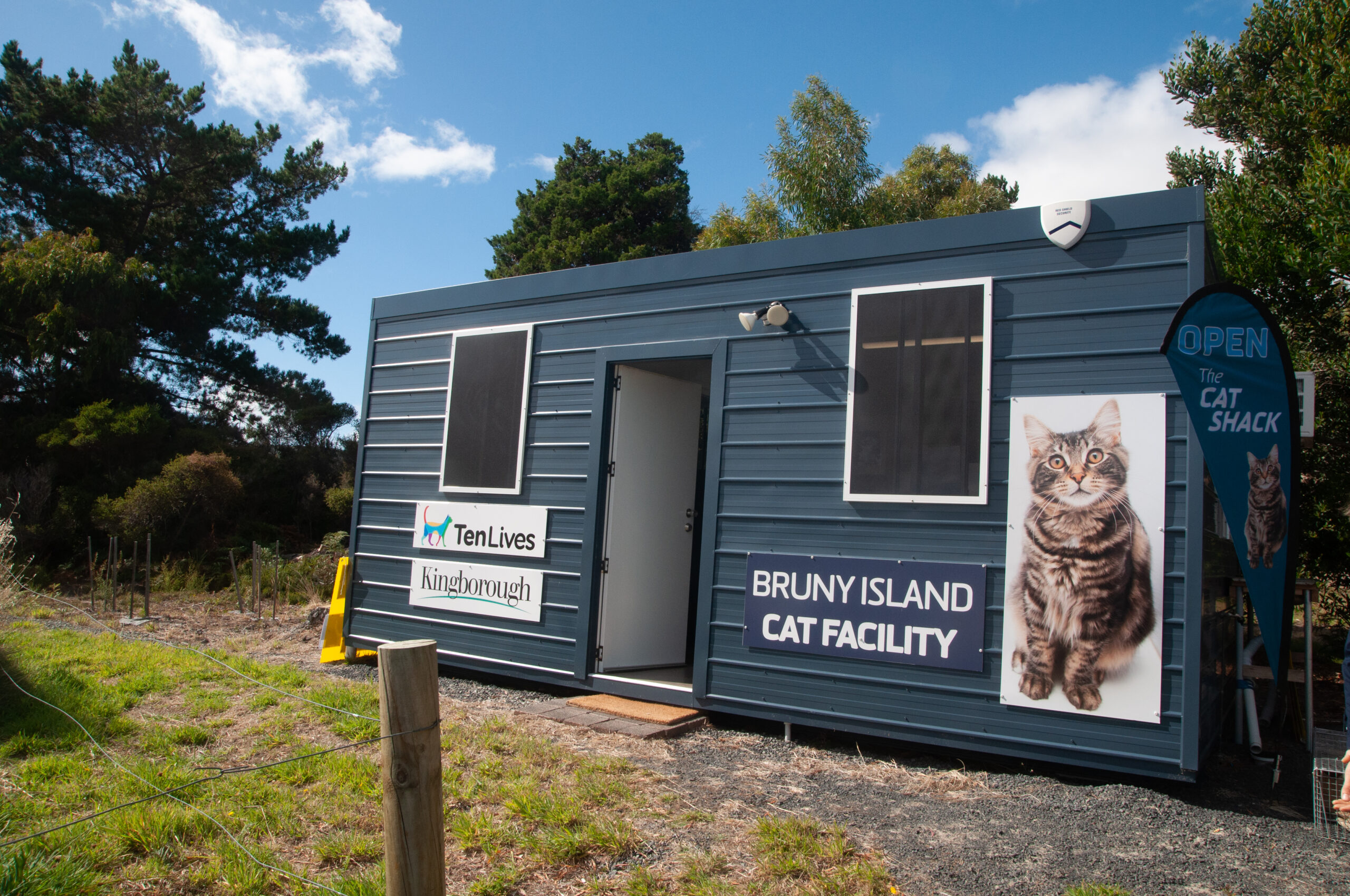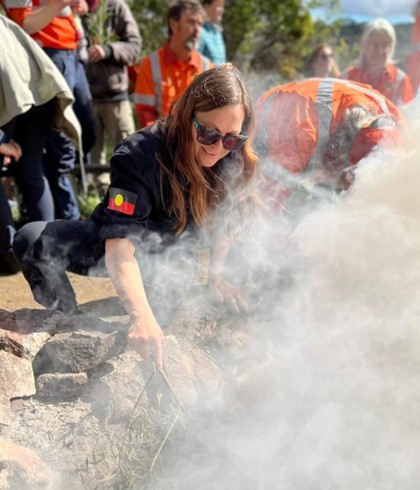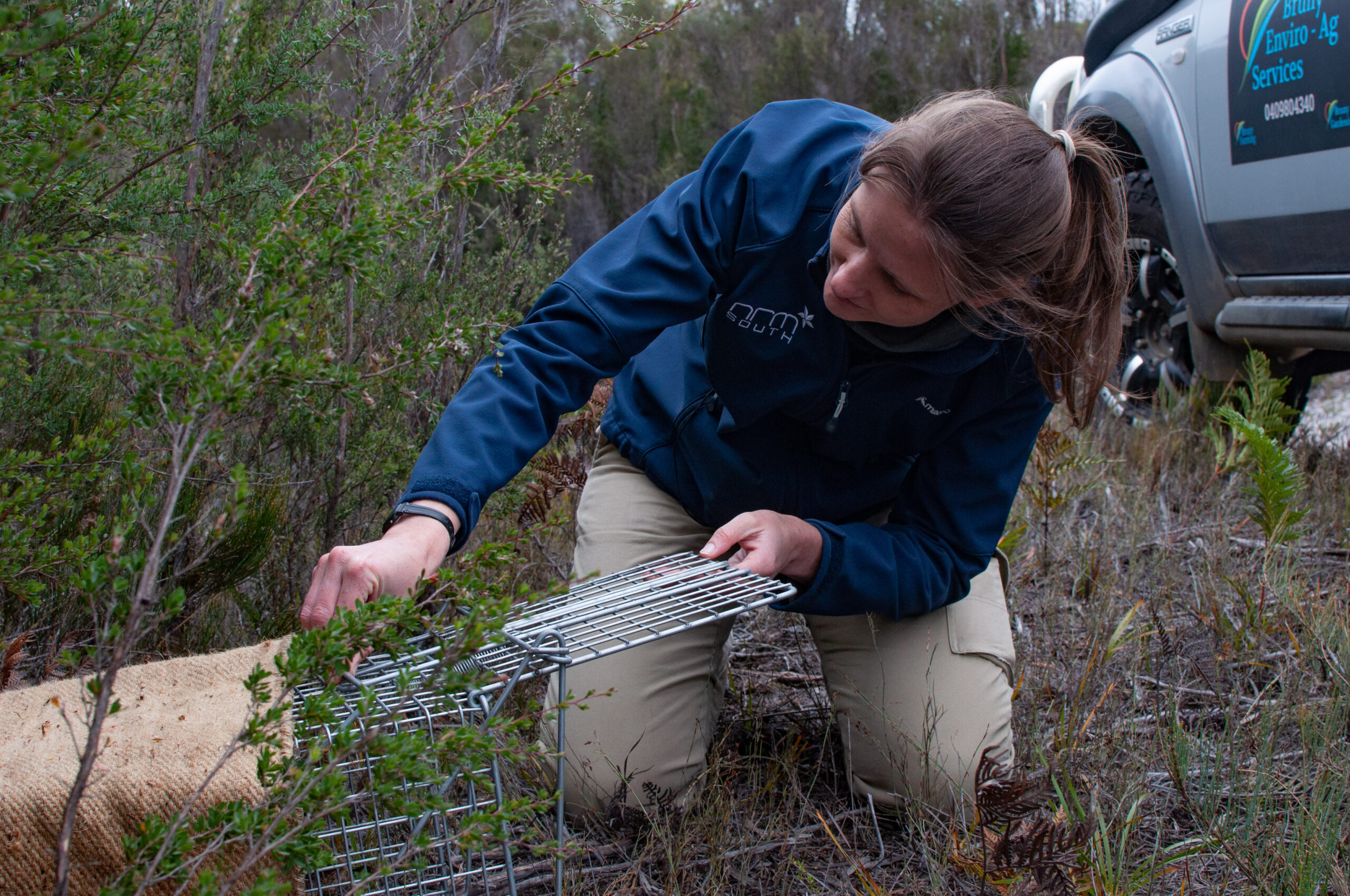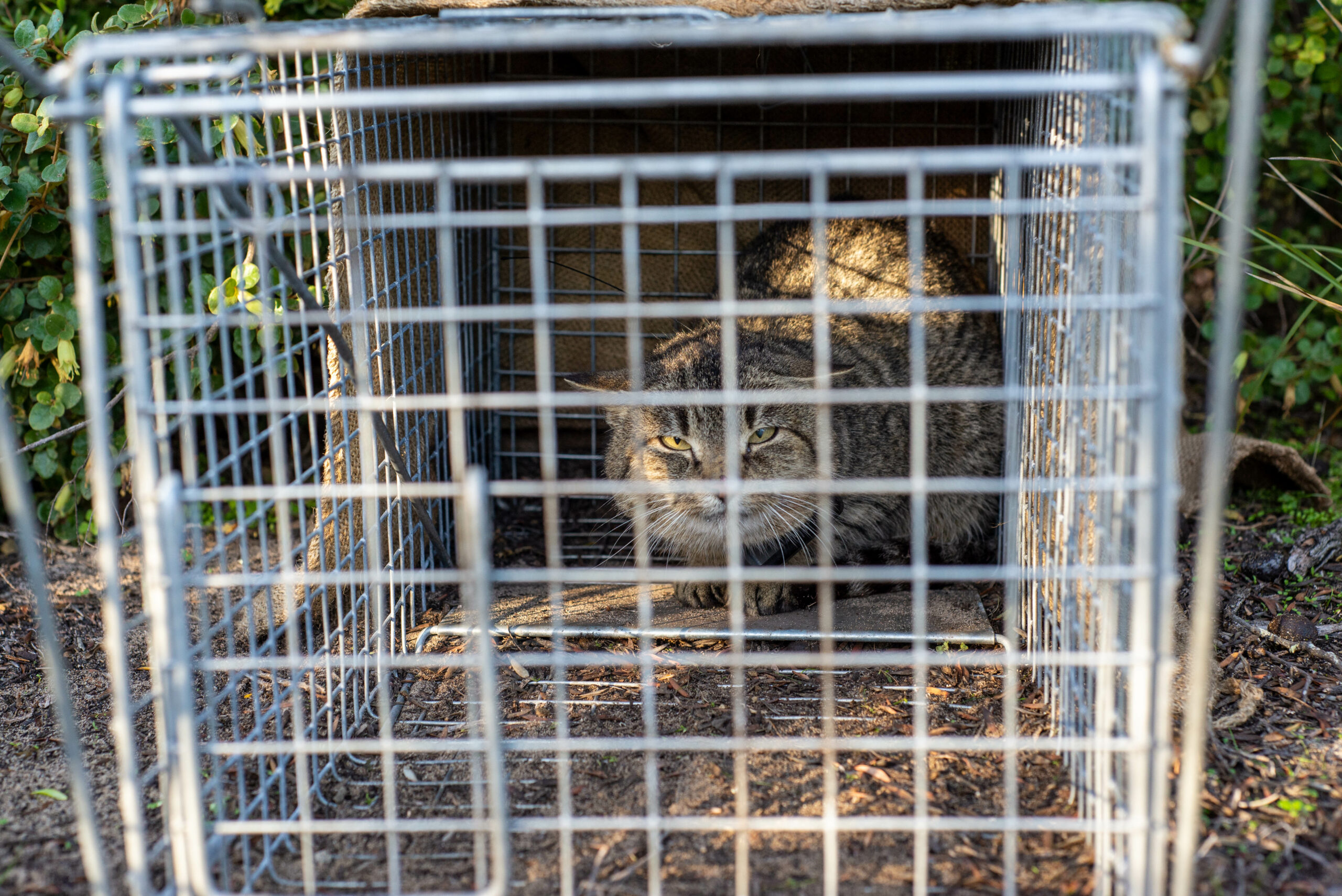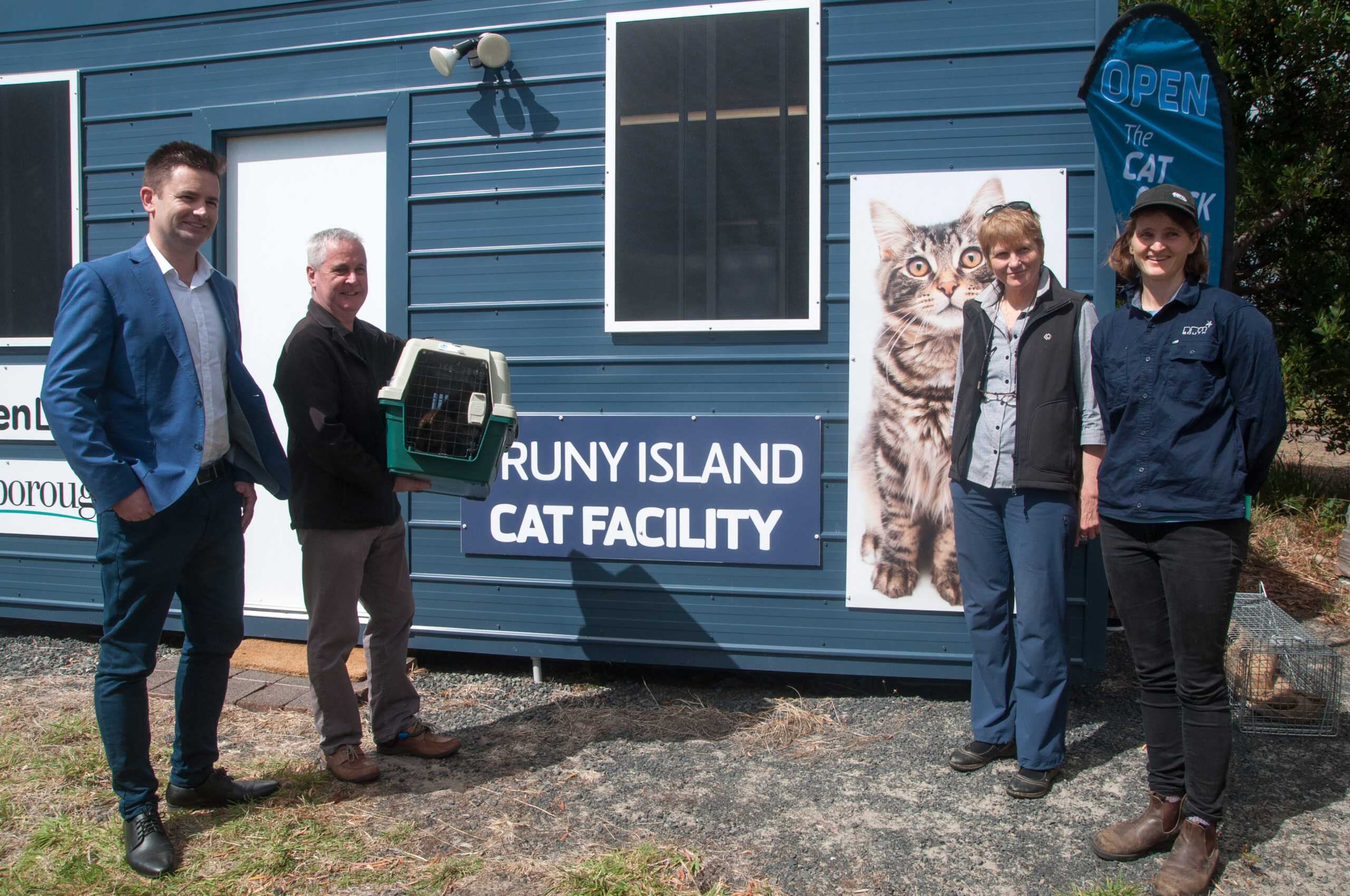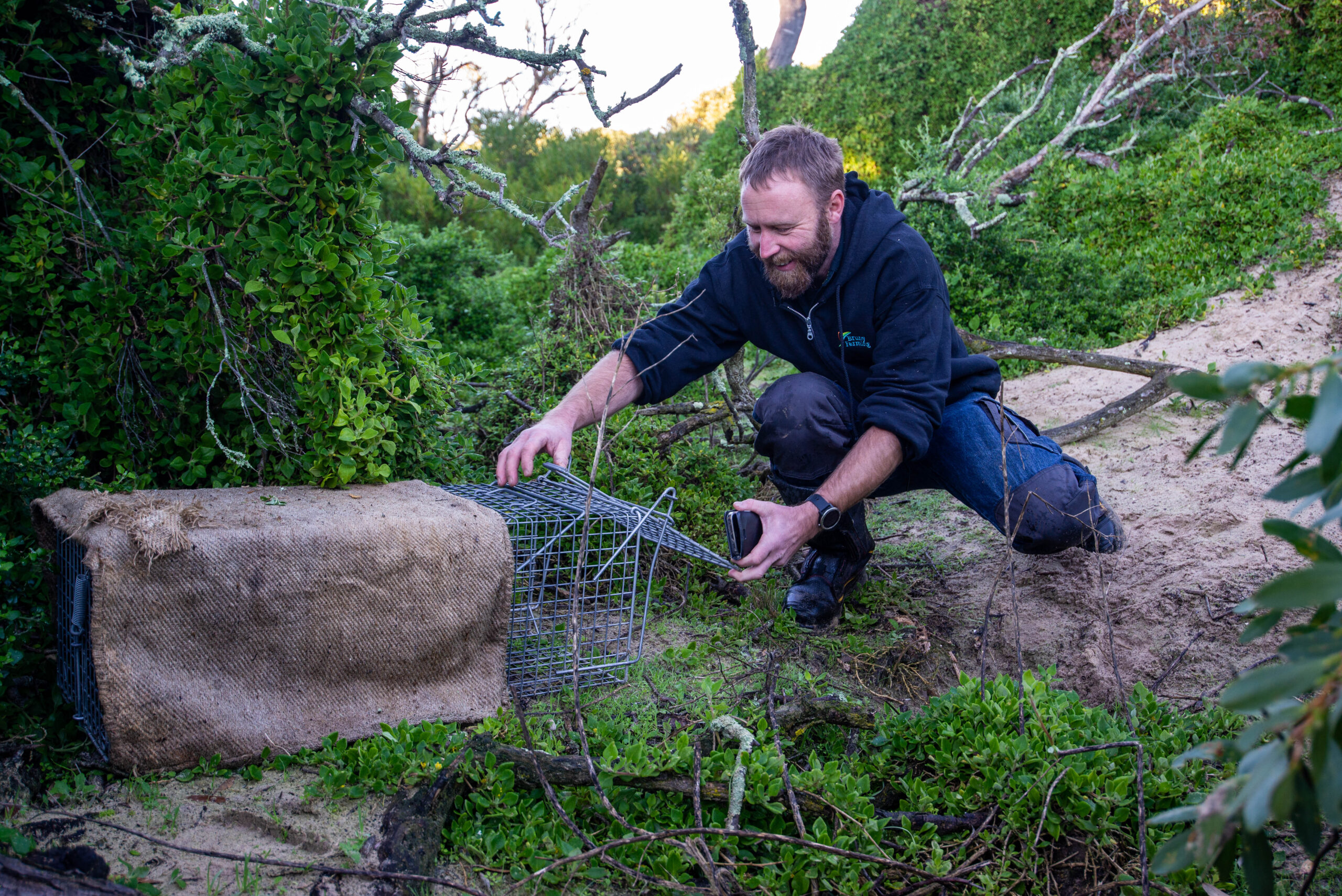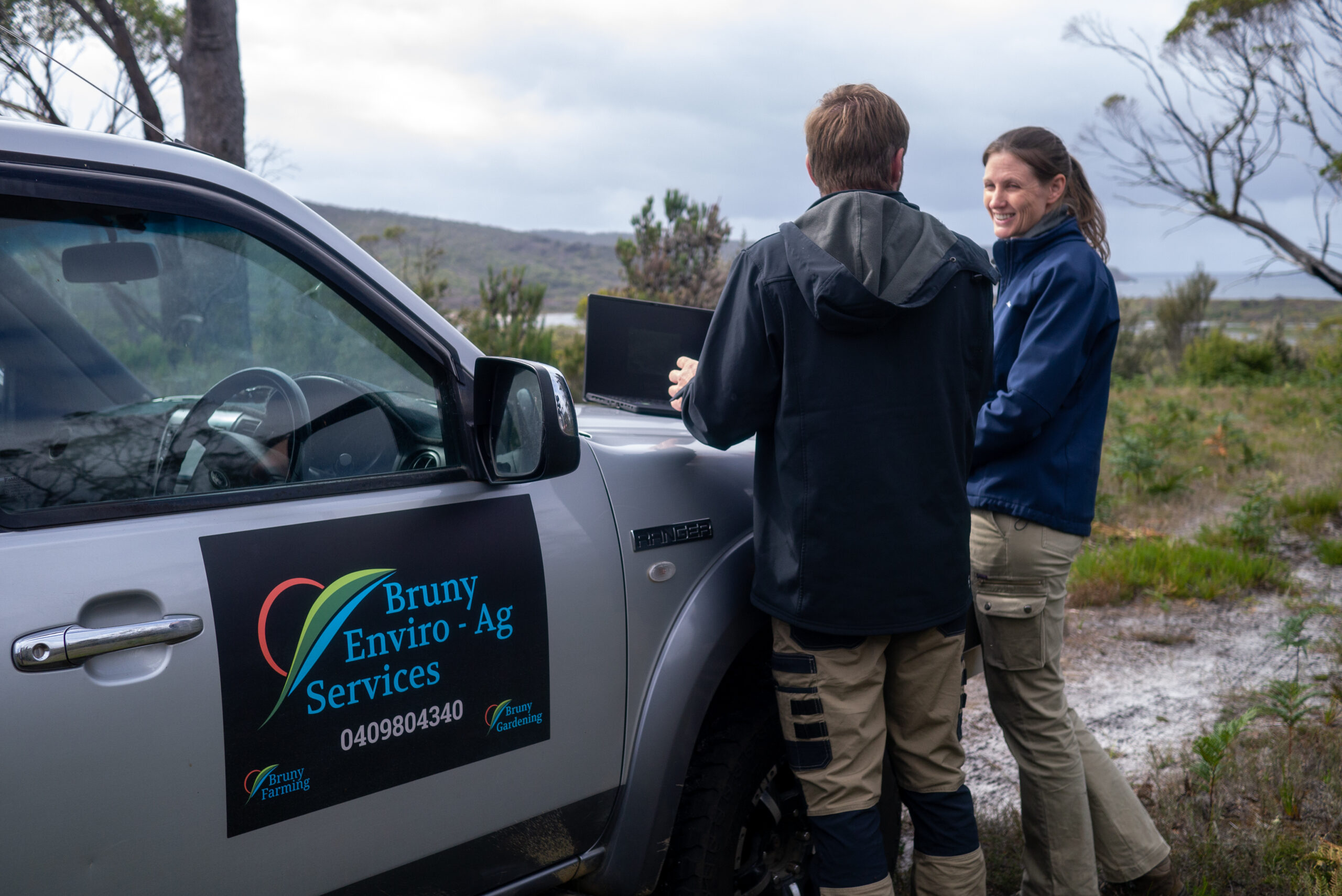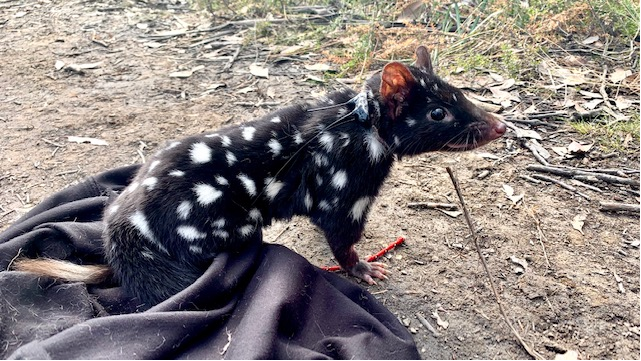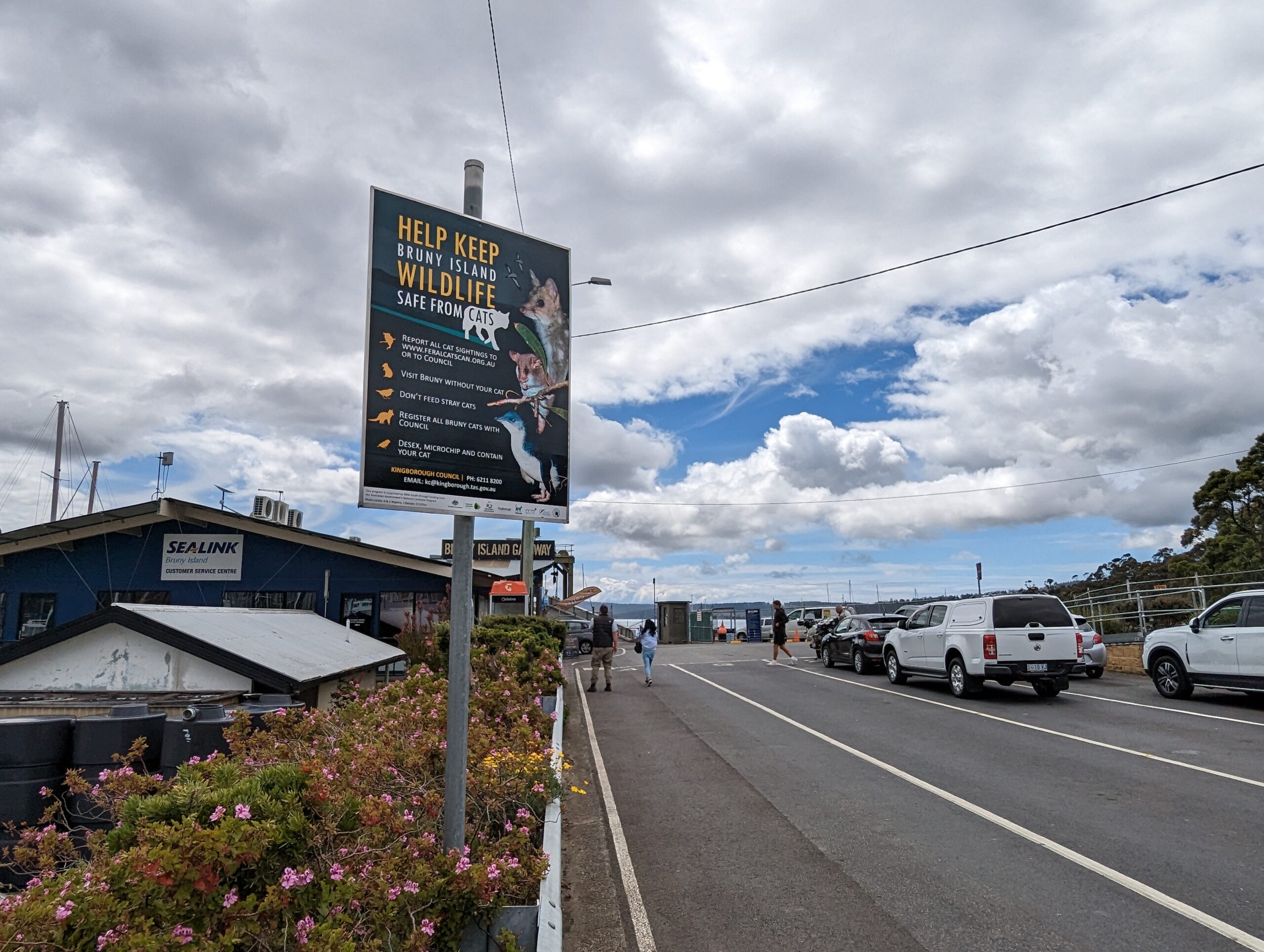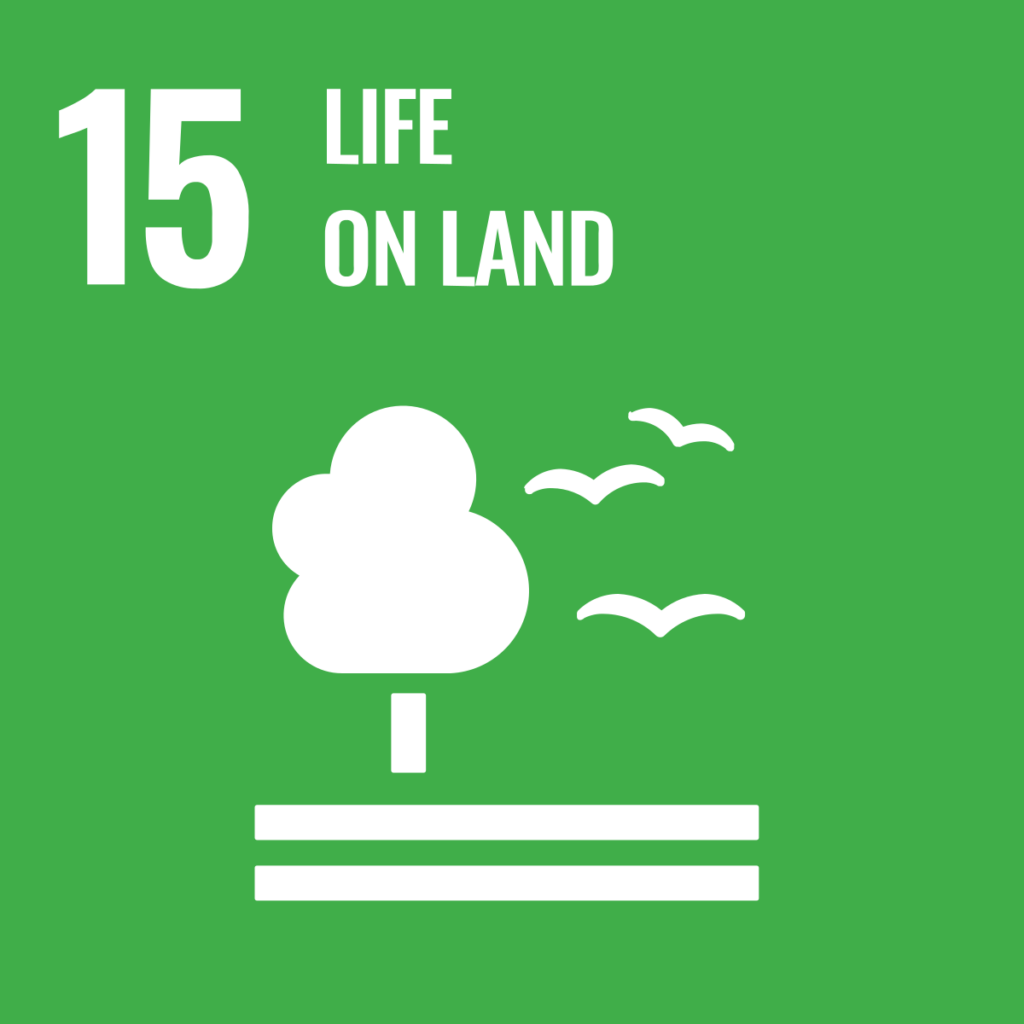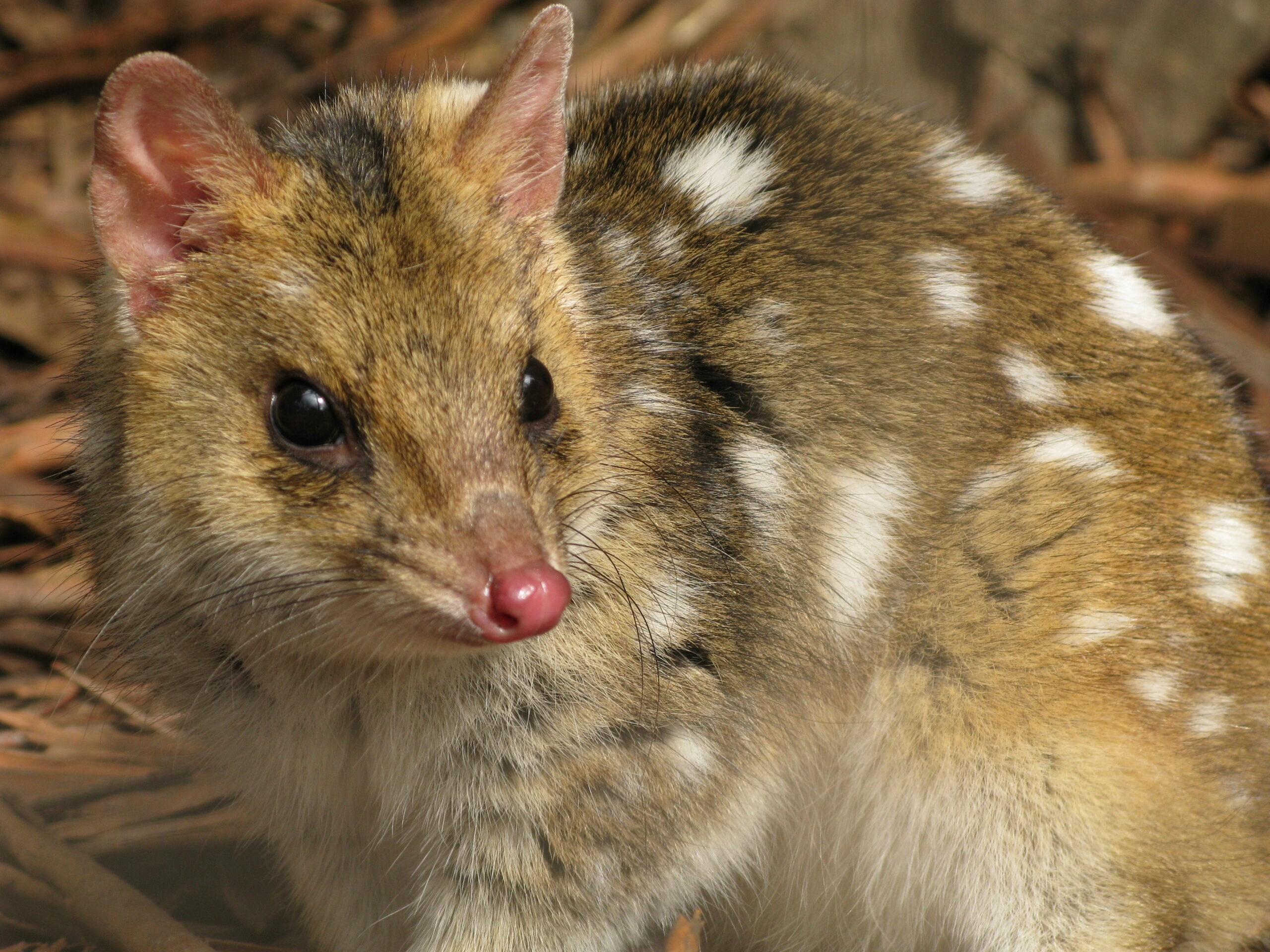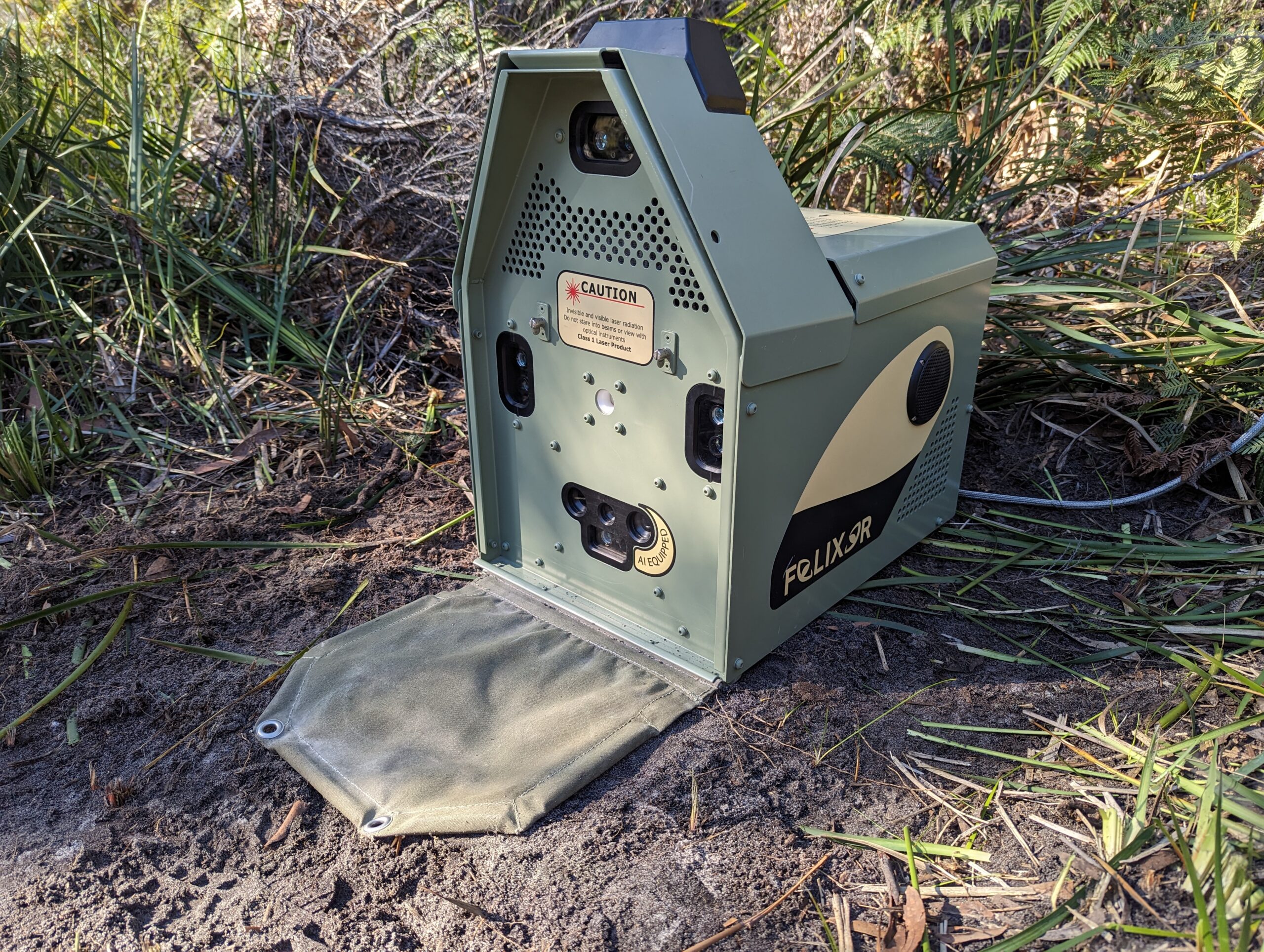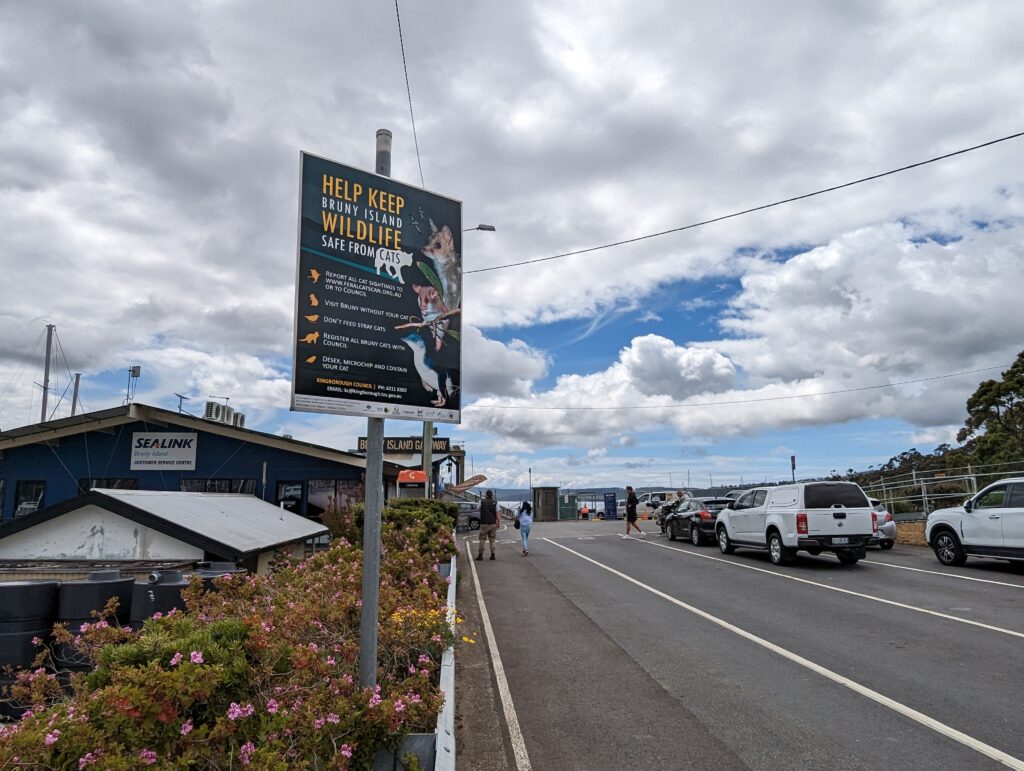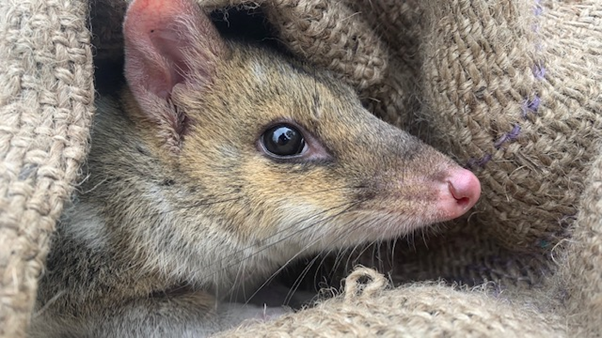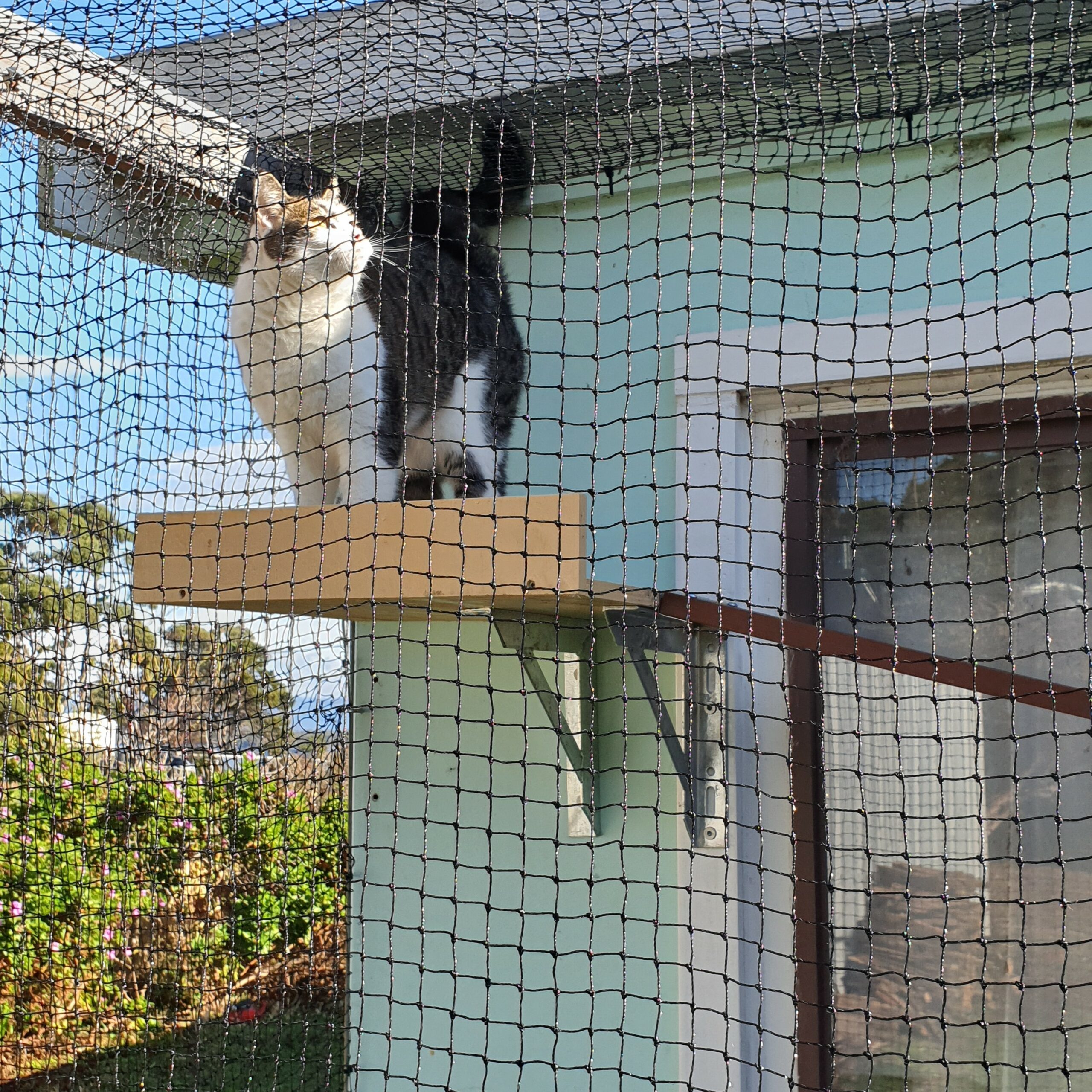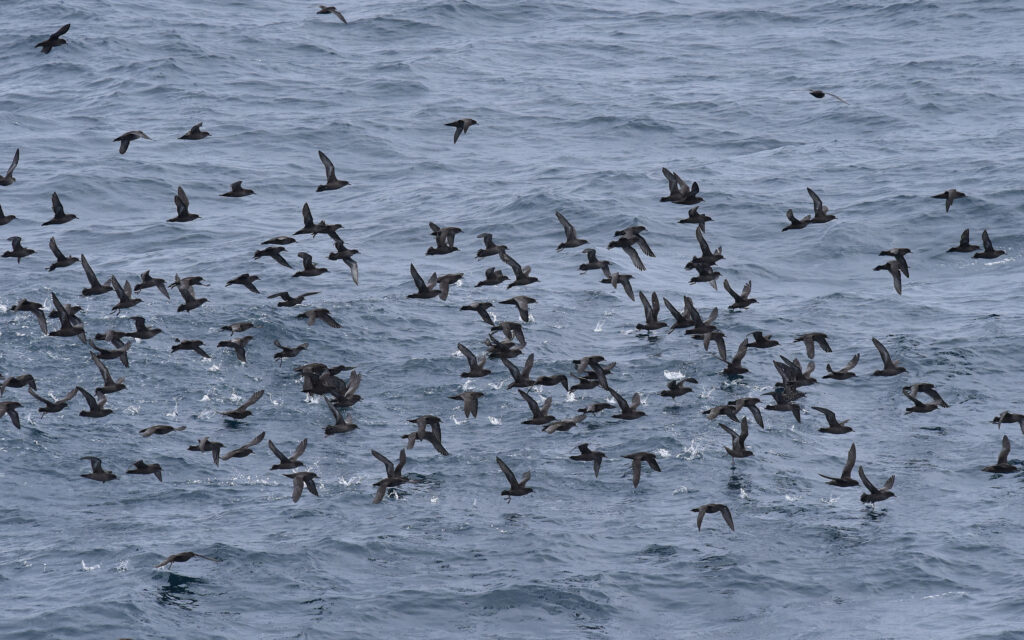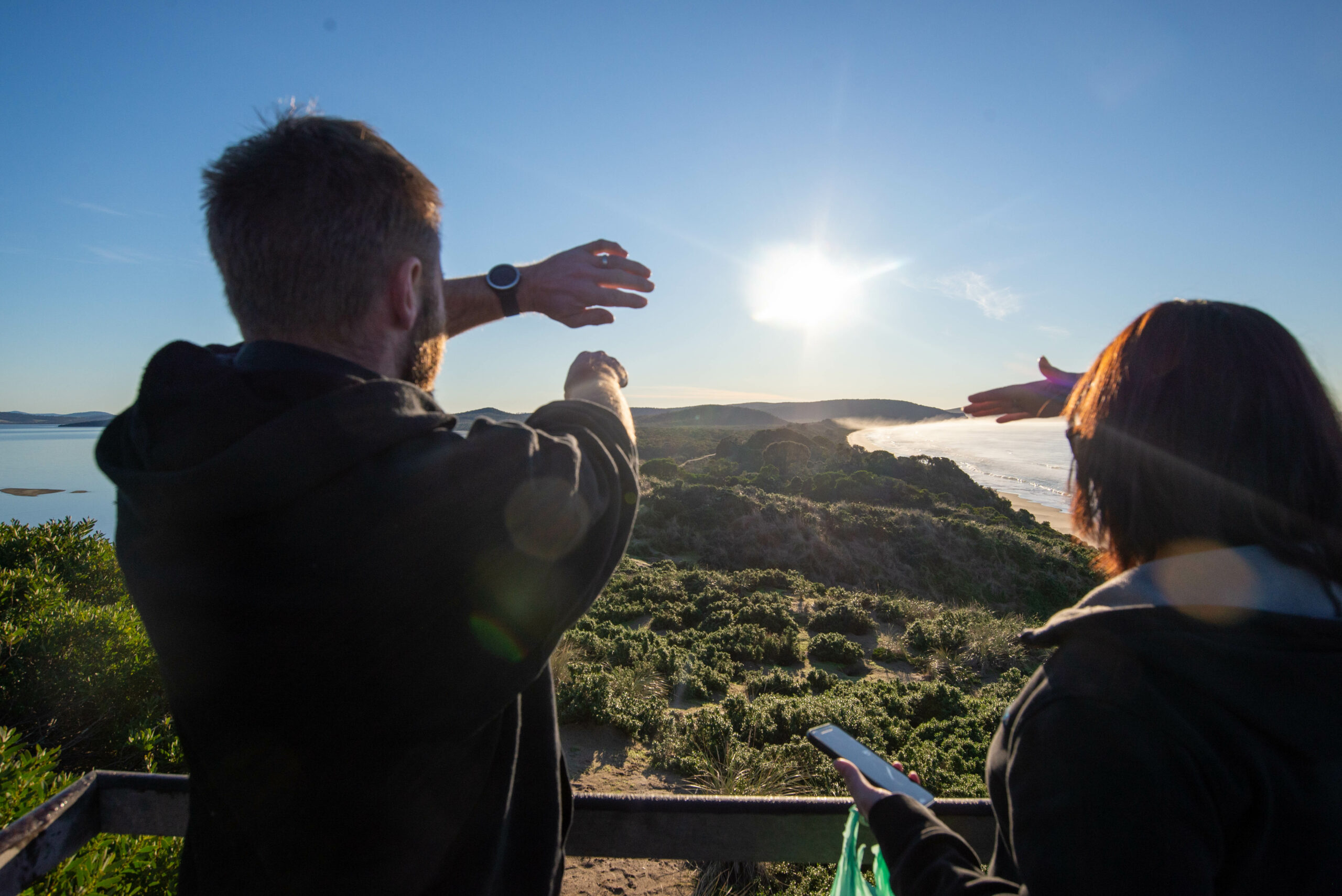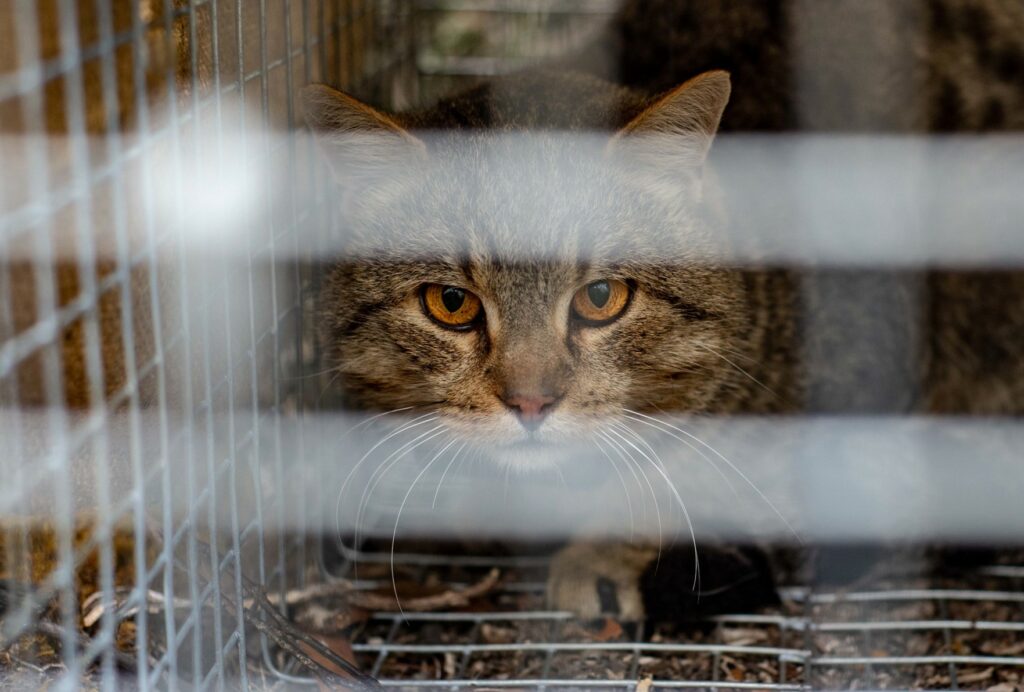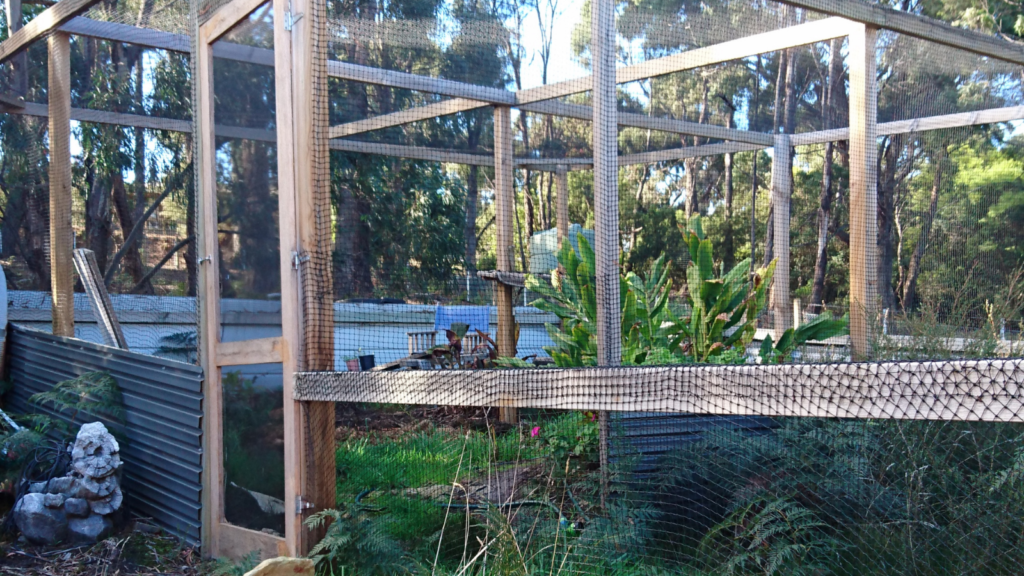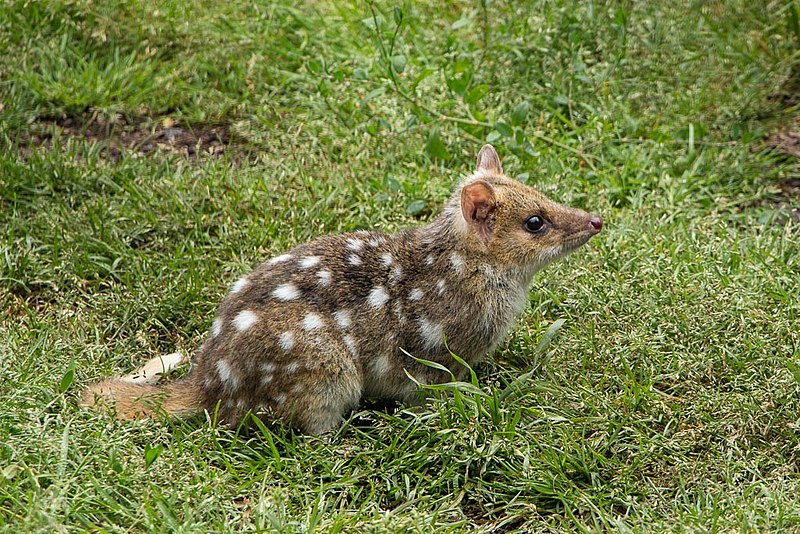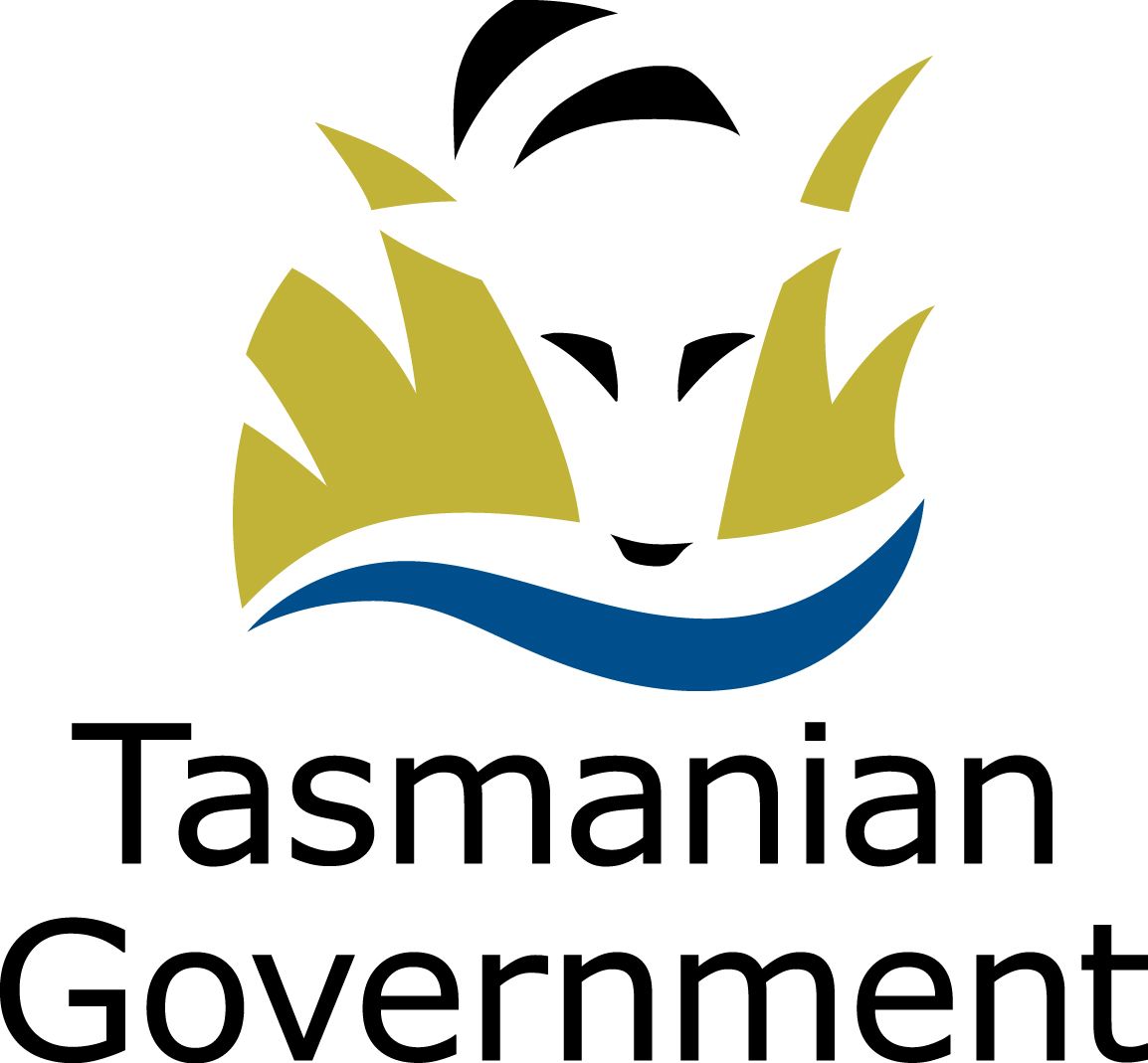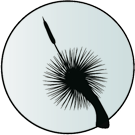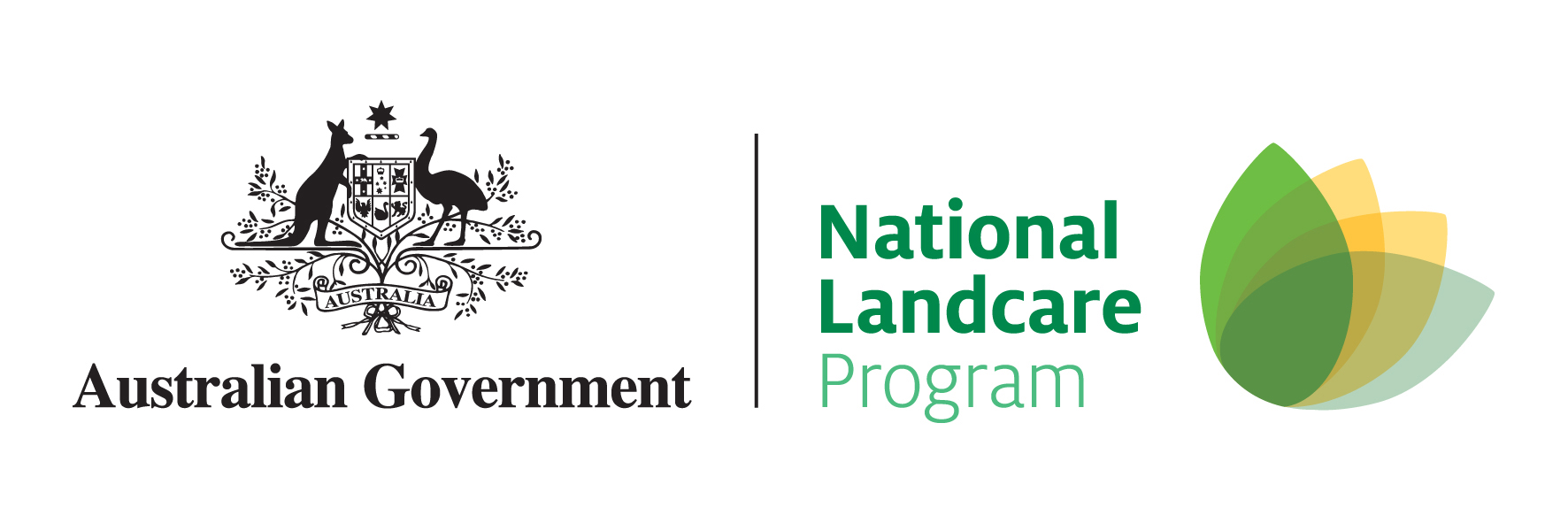Cat Management Actions for Eastern Quoll on Bruny Island
Feral cats have contributed to the extinction of at least 22 Australian mammal species since colonisation and are continuing to drive biodiversity declines across Australia. Removing cats on a landscape scale remains an ongoing challenge in Australian conservation. Islands such as Bruny Island can be valuable safe havens for biodiversity. Island-based cat management programs that work towards eradication can have lasting positive outcomes for wildlife in these landscapes.
Our Approach
This project has helped to protect Eastern Quolls from cat predation on north Bruny Island through the following actions;
- Feral cat control and monitoring changes in cat density across north Bruny Island;
- Removing stray cats from key hotspot areas of Bruny Island;
- Supporting trials of three new feral cat removal methods;
- Using GPS collars to better understand the movement patterns and interactions between cats and eastern quolls;
- Supporting the management of a purpose-built Cat Facility at Alonnah;
- Engaging with the Bruny Island community about responsible cat management practices.
An extension to this project, which runs from June 2023-June 2024, is implementing the following additional actions;
- Ongoing trials of Felixers at Cape Queen Elizabeth for continued control of remaining feral cats
- A feasability study and report on the installation of a cat barrier fence at The Neck, comprising extensive stakehlder engagement, a technical study and an assessment on the impacts of removing cats on the island’s biodiversity.
PROJECT PILLARS CATS
Background
Bruny Island was selected as an ideal site for cat management as it is a critical stronghold for the Eastern Quoll (Dasyurus viverrinus). This species has been extinct on mainland Australia since the 1960s and is one of 20 priority mammal species listed under the 2015 Threatened Species Strategy. Tasmania’s Eastern Quoll population has been steadily declining over the past two decades, due in part to predation by cats. Cat management on Bruny Island aims to support the long-term persistence of this species and other native wildlife on Bruny Island. Cat control also has positive benefits for the island’s sheep farmers, as cats harbour diseases. The Bruny Island ‘By-law’, implemented by Kingborough Council (which requires domestic cats to be contained to their property, registered, microchipped and that no property has more than two cats unless a registered breeder) has made this ambitious project possible. This project built on the 2017-2019 Bruny Island Cat Management project (more information can be found here).
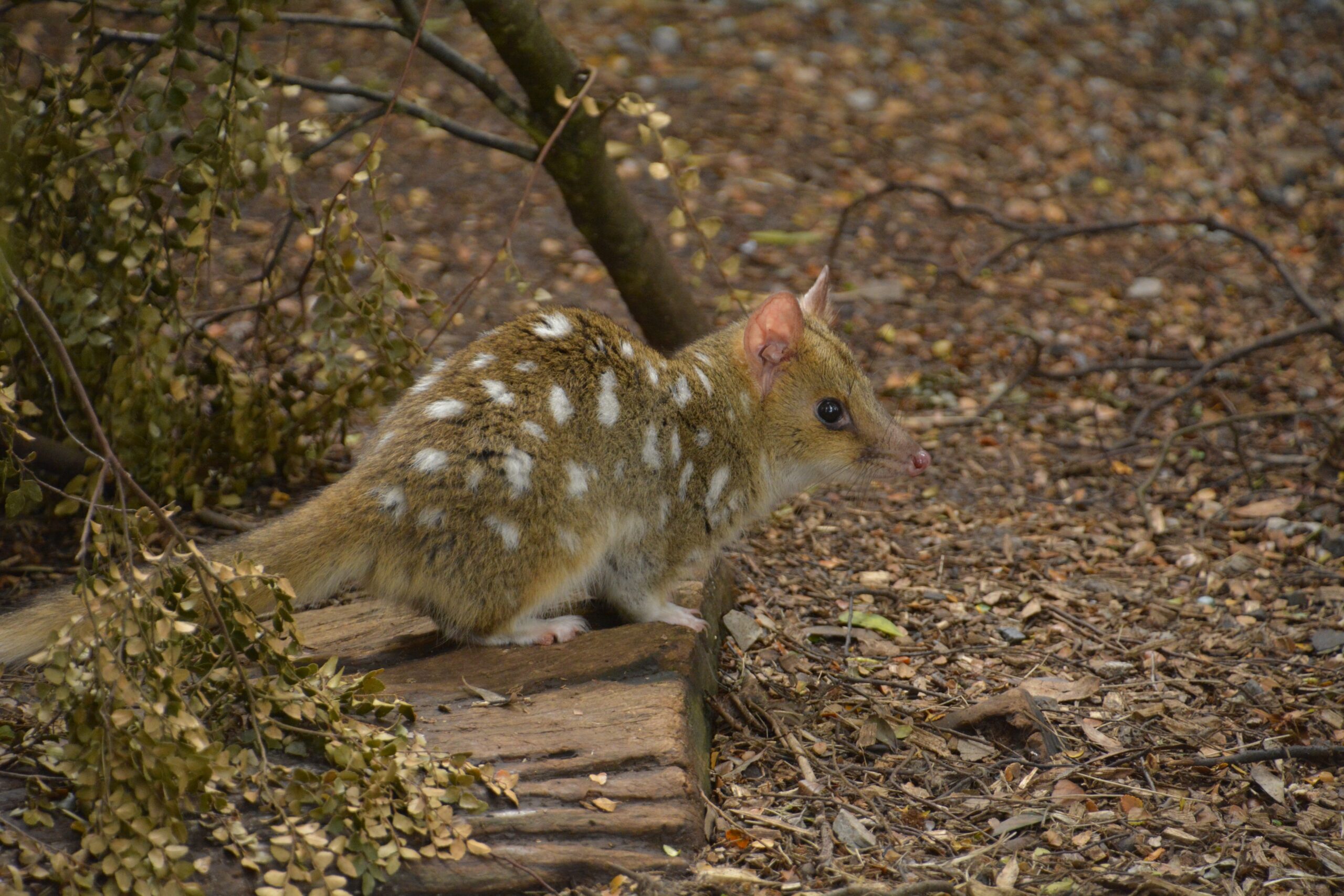
Domestic Cat Management
We supported Kingborough Council to engage with the Bruny Island community and cat owners, to share information about the Bruny Island Cat By-law and responsible cat management practices.
There were 55 registered domestic cats on Bruny Island (as at Dec 2022), and rates of registration and compliance with the Bruny Island Cat By-Law increased from 53% to 74% of households fully compliant with the By-Law, and half of the remaining households close to compliant, over the course of the project. The main major barrier to compliance has been containment to the property. Kingborough Council worked with the Bruny Island Men’s shed to assist cat owners in building suitable catteries for their feline companions.
Stray Cat Removal
Project activities focused on several stray cat hotspots around settlements in the northern part of south Bruny Island. These hotspots were identified during the 2017-2019 Bruny Island Cat Management project. Stray cats are defined by their reliance on humans for supplemental food and shelter. Bruny Farming conducted cage trapping and camera trapping surveys to monitor the population and could act on reports from members of the public of stray cat sightings (often kittens). As part of this control program, every effort was made to ensure cats that are trapped are assessed to check if they are domestic, stray or feral cats or able to be rehabilitated and rehomed.
Camera trapping is integral to the project as it helps to build a picture of the success rate of cage trapping. Where possible, when a cat was recorded on camera, it was individually identified from its fur patterns, and the information added to a database. This information has been critical in tracking cat movements and keeping track of population estimates.
Feral Cat Control
With support from NRM South, control activities north of The Neck were coordinated by Bruny Farming. The primary methods of feral cat control were cage trapping and shooting. The focal areas for control moved seasonally according to where the cats are congregating (usually related to resources) and to limit impacts on native wildlife.
Feral Cat Research
NRM South supported Biosecurity Tasmania to carry out trials of new and emerging techniques for feral cat control that can be added to our toolbox alongside traditional trapping techniques. This included non-lethal trials of thermal shooting, Felixer grooming traps and Curiosity® baits. These types of trials were important for assessing the impact of each control method for the Bruny Island ecosystem.
Thermal shooting
In June 2021, a thermal shooting feral cat control trial was run on north Bruny in shearwater colonies (which attract high numbers of feral cats). Due to the risk of collapsing shearwater burrows, cage trapping of cats can only occur in the colonies when the birds are not present (May-September). However the use of a thermal scope to shoot cats in the colonies greatly reduces this risk and allows us to protect the birds from predation at this critical time.
Thermal shooting uses a heat sensitive scope to pick up an animal’s heat signature within the field of view. The trial showed that cats were easily discernible from other native animals such as possums and quolls, and it was recommended that thermal shooting is a viable control technique. A follow up trial was conducted towards the end of the project.
Curiosity Trial
The Curiosity Baits trial investigated if both cats and quolls would take and eat non-lethal baits. Over the course of the trial, 70% of baits were picked up by quolls, most within five days. It is not known if any baits were ingested by quolls. However, the fact that the quolls removed that baits meant that they were then unavailable for cats and therefore this form of baiting is not considered to be a viable option for feral cat control on Bruny Island.
Felixers
Felixer grooming traps use sensor beams and a computer algorithm to detect animals and distinguish cats from other non-target species (e.g. quolls, possums, wallabies). When a cat is detected, the Felixer sprays a lethal dose of 1080 toxin onto the coat of the cat which it later ingests through grooming. Trials carried out in non-lethal mode showed that the traps did not mis-identify any native species and only selected cats as targets. Following on from the success of this trial, deploying the Felixers in ‘lethal mode’ were explored.
GPS Study
NRM South supported Biosecurity Tasmania to conduct research into the movement patterns and interactions between cats and eastern quolls and fitted 20 Eastern Quolls and five feral cats with GPS collars over the course of this project. Biosecurity Tasmania began GPS collaring feral cats on Bruny in 2018 as there wasn’t much information available about their range, habitat preferences or how they move through the landscape. This type of information was critical to the success of the trapping program as it helps inform when and where to target management actions to ensure the best results.
The data collected as part of this research has been an eye opener in understanding the impacts of cats on Bruny. Some cats have moved significant distances in a single night, regularly moving between seabird colonies, rubbish dumps and farmland. Additional data helps us build a better picture of their habitat preferences, and areas we should target that will make our program more effective and have better results for Bruny’s wildlife and farmers.
Supporting a Cat Facility on Bruny
NRM South supported the management of a purpose-built Cat Facility at Alonnah where stray, roaming or unwanted cats can be brought to for assessment and rehoming (this facility is jointly funded and managed by the Ten Lives Cat Centre and Kingborough Council).
Unowned cats on Bruny, including dense populations around some townships, pose a major threat to the island’s wildlife, tourism and livestock. However, in the past, community members were faced with a four-hour round trip to take any of these cats to the Ten Lives Cat Centre in Hobart. This new facility is helping the community in addressing this problem. The facility is also used to assess cats caught in cage trapping for temperament and suitability for rehoming.
The facility serves as a ‘shop front’ for the project, where community members can bring stray and trapped feral cats and find out more about what is being done across the island to contain pet cats, and control stay and feral cats.
Support for Aboriginal Engagement
As part of this project, funding from Kingborough Council and NRM South has been used to support a Trainee Aboriginal Land Management Officer at the South East Tasmanian Aboriginal Corporation (SETAC).
The trainee role incorporates working on cat management activities on Bruny Island (supported by Bruny Farming), on natural resource management activities in the Kingborough municipality (supported by Kingborough Council) and cultural mentoring to learn about cultural land management, including fire management (supported by SETAC).
Extension Project
The Australian Government has funded a year-long extension project from June 2023-June 2024 that is focusing on two main activities;
1) The ongoing use of Felixers (managed by Biosecurity Tasmania) at Cape Queen Elizabeth, to maintain ongoing pressure on remaining feral cats that are in this area.
2) A feasability study and report into the installation of a cat exclusion fence at the neck. There are three main components to this study;
– Extensive stakeholder engagement across multiple sectors from State Government to local community;
- – A technical feasability study assessing factors such as cost and maintenance, and;
- – An assessment into the impacts of cats on the island’s biodiversity.
Project Achievements
- Removal of 119 cats from the project area
- Compliance of 74% of registered cat owners on Bruny Island with the Cat By-Law.
- Opening of Bruny Island cat facility.
- Feral cat control within the seabird colonies of north Bruny Island.
- Camera monitoring to estimate cat densities across North Bruny.
- Community support for feral cat trapping and camera monitoring.
- Trials of new feral cat control techniques such as thermal shooting.
- GPS collaring study on feral cats and Eastern Quolls.
- A Trainee Aboriginal Land Management Officer funded by NRM South and Kingborough Council and employed through SETAC.
- Signage installed at the Sealink ferry terminal informing travellers about responsible cat ownership on Bruny Island.
- Trial completed investigating the feasability of Felixer traps.
- A forum with the Bruny Island farming community was run discussing cat impacts on agriculture, and a presentation was given at the Bruny Bird Festival about cat impacts on Bruny Island’s bird populations.
Key Milestones
119 cats removed from project area
74% of cat-owning
households compliant with By-Law
Signage at Kettering ferry terminal
Curiosity baiting trial and Felixer trial complete
GPS research into cats and quolls
What's Next
This project ran until June 2023. A year-long extension project is underway and will wrap up in June 2024.
